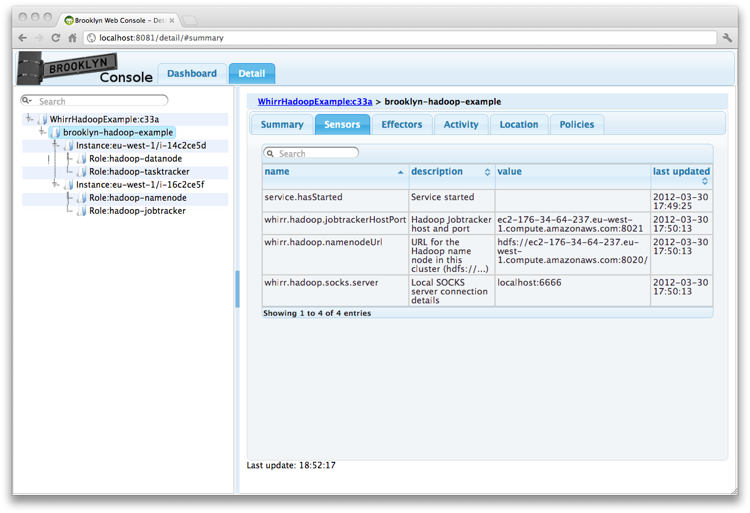Whirr Hadoop Cluster
Before You Begin
To use the examples, you'll need curl, git, java (1.6+), and maven (v3) installed.
Installing Brooklyn
(If you followed the Getting Started instructions, you can skip to Installing the Examples.)
Grab a copy of the Brooklyn distribution and set up BROOKLYN_HOME:
% curl -LO http://repo1.maven.org/maven2/io/brooklyn/brooklyn-dist/0.5.0/brooklyn-dist-0.5.0-dist.tar.gz
% tar xvzf brooklyn-dist-0.5.0-dist.tar.gz
% export BROOKLYN_HOME=$(pwd)/brooklyn-0.5.0/
Installing the Examples
Grab a copy of the brooklyn-examples source code and build with Maven:
% git clone https://github.com/brooklyncentral/brooklyn-examples.git
% cd brooklyn-examples
% git checkout 0.5.0
% mvn clean install
For more information on ways to download Brooklyn please see the download page. For more information on the Brooklyn CLI and launching apps, please visit this section of the user guide.
Now, go to this particular example's directory:
% cd hadoop-and-whirr
The CLI needs to know where to find your compiled examples. You can set this up by exporting
the BROOKLYN_CLASSPATH environment variable in the following way:
% export BROOKLYN_CLASSPATH=$(pwd)/target/classes
The project hadoop-and-whirr includes deployment descriptors
showing how to provision Whirr-based clusters from Brooklyn,
including setting up a Hadoop recipe.
Background
Apache Whirr is an open-source project providing a set of libraries for launching cloud services in an easy, repeatable, and reliable way.
Brooklyn can use Whirr to launch a wide variety of services and integrate them as part of bespoke applications.
Whirr Hadoop
The class WhirrHadoopExample shows how a Hadoop cluster can be started
with an arbitrary size, using the WhirrHadoopCluster entity.
public class WhirrHadoopExample extends AbstractApplication {
@Override
public void init() {
WhirrCluster cluster = addChild(EntitySpecs.spec(WhirrHadoopCluster.class)
.configure("size", 2)
.configure("memory", 2048));
}
}
You can run this by running:
% ${BROOKLYN_HOME}/bin/brooklyn launch --app brooklyn.extras.whirr.WhirrHadoopExample --stopOnKeyPress --location aws-ec2:eu-west-1
This targets aws-ec2:eu-west-1 (using jclouds),
so you will need to set your AWS credentials as described here.
Once it is running, navigate to the Brooklyn web console to see the NAME_NODE_URL sensor.
(And not that using attributeWhenReady,
you can easily configure a larger application to use its own dedicated Hadoop cluster.)
Custom Whirr Recipe
The class WhirrExample shows how an arbitrary Whirr recipe
can be run from within Brooklyn:
public class WhirrExample extends AbstractApplication {
public static final String RECIPE =
"whirr.cluster-name=brooklyn-whirr"+"\n"+
"whirr.hardware-min-ram=1024"+"\n"+
"whirr.instance-templates=1 noop, 1 elasticsearch"+"\n";
@Override
public void init() {
WhirrCluster cluster = addChild(EntitySpecs.spec(WhirrCluster.class)
.configure("recipe", RECIPE));
}
}
This can be launched by running:
% ${BROOKLYN_HOME}/bin/brooklyn launch --app brooklyn.extras.whirr.WhirrExample --stopOnKeyPress --location aws-ec2:eu-west-1
In the provided example this will deploy to AWS.
If you would like to deploy to localhost, you can do this by running the same command and replacing aws-ec2:eu-west-1 with localhost. However, please note that currently there are some limitations when deploying to localhost:
- You can not deploy more than one server (noop doesn't count in the above case).
- This has only been tested on Ubuntu 10.04 and might cause problems on other operating systems.
- Your user will need to be configured for passwordless ssh and passwordless sudo on localhost.
Feel free to experiment with the instance template parameter, trying out other recipes from Whirr.
With this mechanism, you can roll out Whirr-supported systems, ranging from Cassandra to Voldemort, including integrating Chef and Puppet scripts you may wish to use. The Whirr state is loaded into Brooklyn, as well as saved to disk in the usual Whirr way. This means it is available for programmatic extensions (as is used for Hadoop), including defining sensors and effectors and applying policy: stop is available, with resize expected soon (making it easy -- or at least much easier -- to write custom elasticity policies).
Integrating with Other Entities
The real interest of Brooklyn working with Whirr, of course, is to combine systems such as Hadoop
with your custom applications which use these systems.
One example, combining the Global Web Fabric example
with the Whirr Hadoop entity, is included in this example project.
A Hadoop-based chatroom web app, performing map-reduce (and a few necessary contortions to work with private subnets)
is in WebFabricWithHadoopExample.
